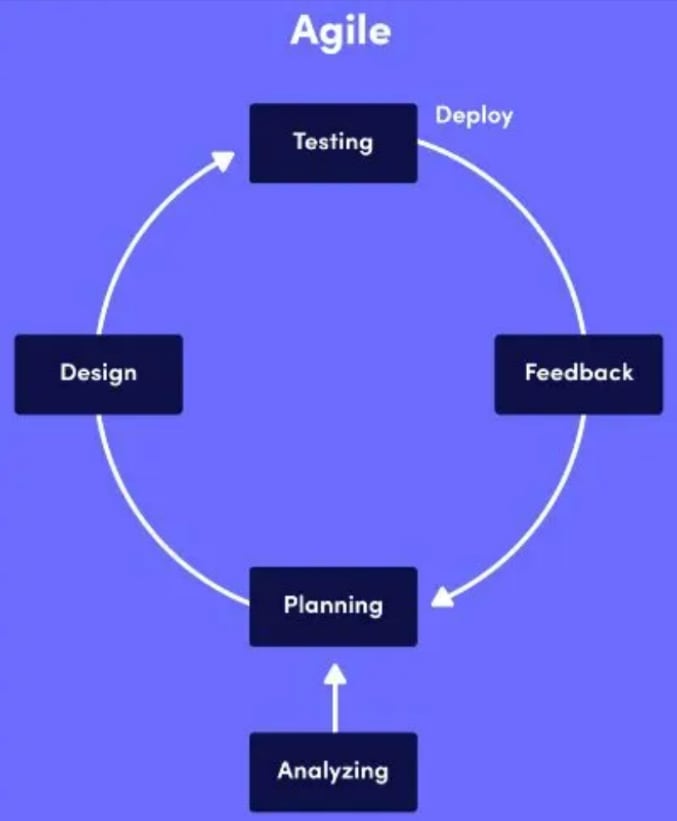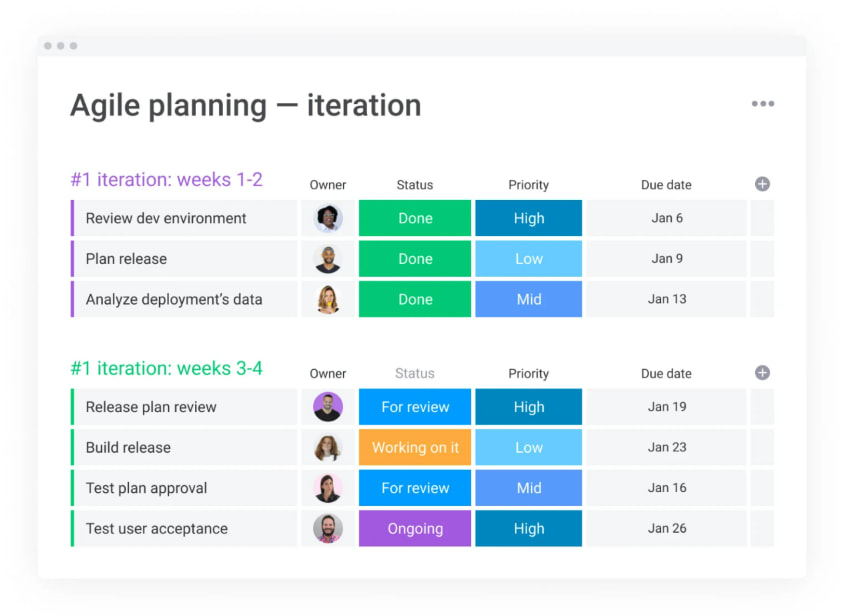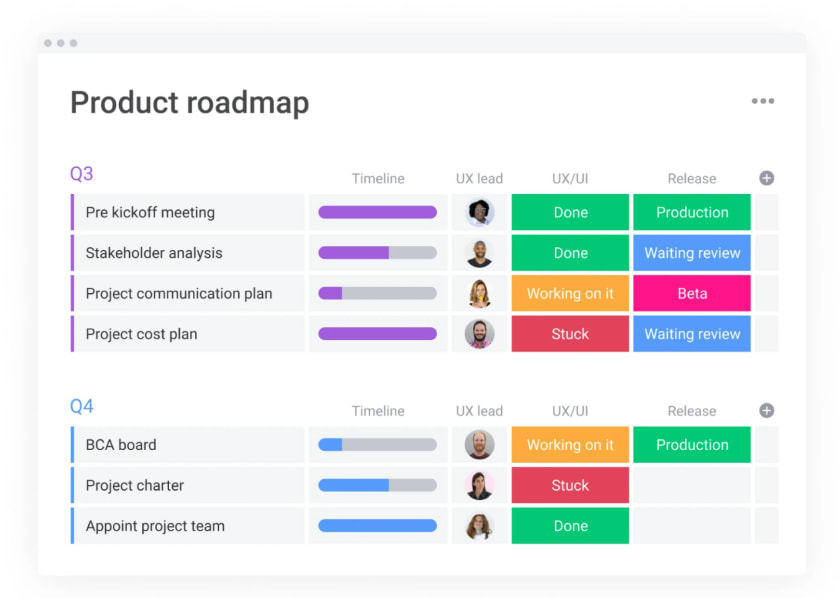Agile project management certification: a complete guide
Blog: Monday Project Management Blog
Agile project management has its roots in software development, but today it’s used widely in everything from marketing campaign management to scientific research.
If you want to understand the fundamental principles behind the agile approach, you might want to consider Agile project management certification. But with so many courses to choose from, it can be tricky to work out which way to go.
In this article, we’ll break down what to look for in an Agile project management course. We’ll explore the potential benefits of getting a formal certification, and walk you through what to expect from a course. Finally, we’ll outline why monday.com’s Senior SEO Manager, Zoe Averbuch, highly recommends an Agile project management certification.
What is Agile Project Management?
Agile project management is a way of managing projects by breaking them down into short cycles, working closely with customers, and being flexible to change.
Agile project management evolved as a way of developing software more rapidly. Unlike linear project management approaches like the waterfall method, the Agile method is iterative. A version of the software is released as quickly as possible, and then improved based on customer feedback.

The four core values of the Agile manifesto are:
1. Individuals and interactions over processes and tools
2. Working software over comprehensive documentation
3. Customer collaboration over contract negotiation
4. Responding to change over following a plan
In other words, the approach prioritizes delivering and then iterating upon the end product over creating formal documentation or following a prescribed plan.
Agile project teams break down the project into short time periods, known as sprints. At the end of the sprint, the work is evaluated and improved upon based on changing customer requirements and an evolving understanding of the project itself.
What are the benefits of an Agile approach to project management?
Agile has become increasingly popular in recent years. It’s ideal for projects that are complex, subject to frequent changes, or that have a high degree of uncertainty. The major benefits of Agile over other project management methodologies are:
-
It allows project teams to be more flexible.
As anyone who has managed a project can tell you, projects tend to evolve over time. They may increase or decrease in scope, become more complex, or shift their focus as the needs of the customer or end-user change. Traditional project management techniques like the Waterfall approach can struggle to accommodate these changes, leading to delays in project delivery.
With the Agile method, flexibility is built into the process itself. Projects are undertaken in collaboration with customers or stakeholders and project goals are revisited after every sprint, to keep them in close alignment with end user requirements.
-
Value is delivered to customers more quickly.
Before Agile became the go-to method for software development, development cycles could take months, or even years. Customers could be left waiting impatiently for a new version of the software that would better address their needs or fix major bugs.
Agile is a much more fast-paced approach. Project teams incorporate customer feedback on an ongoing basis. They release new versions constantly, instead of waiting until the product is completely ready.
-
It promotes a more efficient use of resources.
With a linear approach to project management, it’s hard to identify the need to change the deliverables, focus or objectives until the project is complete. If the client is unhappy with the result, it’s a question of scrapping the whole project and starting again from scratch.
The 6 most popular Agile project management certifications
There’s a wide range of Agile project management certifications out there. In some cases, you need to complete a course and then pass an exam in order to be certified. In others, you simply need to pass the exam.
Here are a few of the most popular certifications available. (Please note: the duration of the certification process and the costs involved will vary depending on the provider, format and dates.)
1. Certified ScrumMaster (CSM)
This course focuses on the Scrum methodology, which is a popular Agile framework. Offered by the ScrumAlliance, the target audience includes project managers, software developers, and product owners, as well as those in non-software roles like marketing and HR. The course covers the basics of Scrum, including the roles, sprints, and retrospectives.
Estimated cost: From $795
Estimated duration: 16 hours
2. Professional Scrum Master (PSM)
Delivered by Scrum.org, this certification also focuses on the Scrum methodology. There are three levels of certification available: PSMI, PSMII or PSMIII.
- PSMI covers the fundamentals of Scrum and especially on how to take on the role of ScrumMaster (the lead on a Scrum-based project).
- PSMII is more advanced, and covers the principles of team and project management using the Scrum method.
- PSMIII is for experienced Scrum Masters, and covers the application of Scrum in complex projects and teams.
Estimated cost: From $985
Estimated duration: 16 hours
3. PMI Agile Certified Practitioner (PMI-ACP)
Offered by the Project Management Institute, this certification covers Agile project management in general. In addition to Scrum, you’ll also need to be familiar with other Agile methods like Kanban, Lean, extreme programming (XP) and test-driven development (TDD).
The certification is appropriate for project managers, program managers, and team leaders who have experience in the Agile methodology, at least 1 year of experience in project management, and a secondary degree.
Estimated cost: $495
Estimated duration: A 3-hour exam
4. Certified SAFe Agilist (SA)
This certification focuses on the Scaled Agile Framework (SAFe), which is a methodology for scaling Agile practices across large organizations. To get SAFe certified, you’ll need to attend an official SAFe course first. During your course, you’ll learn the theory and practice of the SAFe methodology, and how to align massive organizations around the SAFe approach.
Estimated cost: From $545
Estimated duration: 16 hours
5. Kanban Management Professional (KMP)
This certification is granted by Lean Kanban University. It’s aimed at project managers, engineers and executives who want to understand how to implement the Kanban approach to Agile project management in their organization.
To get certified, you’ll need to complete an official Kanban training course.
Estimated cost: From $850
Estimated duration: 16 hours
6. Agile Crash Course
If you just want to get the basics of Agile under your belt, then the Agile Crash Course comes with certification. Offered by Udemy, this Agile crash course will introduce you to the key concepts of Agile Development, Project Delivery and Project Management in a concise and approachable way.
Estimated cost: $150
Estimated duration: 2h 42m
What can you expect from an Agile project management certification course?
As you can see, there’s a large variety of different Agile project management certifications out there, and the training courses will also vary widely. However, most Agile project management courses will cover:
- The definition and theory behind the Agile approach to project management
- The Agile manifesto–the 4 values and 12 principles
- What makes Agile different from traditional project management
- The roles in an Agile project team
- Key Agile terminology: sprints, the product backlog, user stories, sprint velocity, and the minimum viable product
- How to introduce Agile to your company or team
- How to apply Agile in different project scenarios
Is Agile project management certification worth it?
Zoe Averbuch, a Senior SEO Manager at monday.com, recently completed Agile project management certification. She told us that pursuing Agile certification would be a great idea for anyone with project management responsibility, because:
-
It helps to give you a unified understanding of the Agile methodology.
The Agile approach is a huge topic online, so trying to gain a comprehensive understanding of the method on your own can be a little overwhelming. What’s more, so much of the information you can find online isn’t really about the Agile method.
For Averbuch, one of the biggest advantages to completing an official certified course is that it “sums it all up so nicely”. By the time you’ve received your certification, you’ve gained a full understanding of the Agile method and how to apply it in the workplace.
-
You get deeper insights than you can find on your own.
Sure, you can research Agile at length online, but as Averbuch points out, often you’ll simply see the same few topics covered again and again.
With a certified course, you’ll receive instruction from a qualified Agile project management expert, meaning that you can gain far richer and more practical awareness of how Agile works.
-
It enables you to apply Agile approaches to your existing project management workload.
At monday.com, we’re big fans of the Agile approach, so Averbuch has found the certification handy in the workplace. As she puts it, “monday.com really stresses perfection through iteration”, a mindset that is key to the Agile approach.
The goal is to get value to the customer as quickly as possible, and then improve on that value with each iteration of the project.
In our Content projects, for instance, Averbuch explains that the goal is to publish high-quality content quickly, then gather feedback and review performance metrics so we can improve the content over time.
How can you use monday.com for Agile project management?
If you’re considering Agile project management certification, then you might want to check out monday.com Work OS – it’s a great fit for the Agile approach. We know that because we use it ourselves!
Here are a few ways that monday.com makes Agile project management easier:
1. Plan your sprints with a digital sprint board
Instead of planning out sprints on a whiteboard, you can use or customize our ready-made templates to create a digital sprint board. Use the Owner column to assign sprint roles pr color code task statuses to get a quick visual overview.

2. Make your morning standups a breeze with a real-time roadmap
Agile project management is all about transparency and collaboration—and so is monday.com. Use a product roadmap to keep track of your project progress, and automatically update the roadmap by connecting board items to sprint activity statuses.

3. Share your progress with clients and other stakeholders
Involving your clients and end users is a key part of Agile, and monday.com makes it easy. You can assign different levels of guest access to project stakeholders, such as a VIP client or project sponsor, to keep everyone on the same page and promote transparency.
FAQs
1. What is Agile project management certification?
Agile project management certification is the process of becoming officially certified in using the Agile methodology to plan and manage projects. Agile is an approach to project management that involves breaking projects down into short time periods, delivering a result as quickly as possible, and then iterating on the result over time using feedback from customers or end users.
2. Which Agile certification is best for project managers?
There are a huge number of Agile certifications out there for project managers. We’ve included a few suggestions for some of the top-rated courses here, but the best fit for you will include the time you have available, your budget, location and preferences. For instance, if you work in a large organization, you might want to consider SAFe certification. Or, if you just want a quick introduction to Agile, Udemy’s Agile Crash Course might be a better fit.
3. How can I get certified in Agile project management?
If you have no experience working with Agile, then you’ll need to complete a course on Agile project management before you can be certified. You’ll then need to sit a test or exam. If you already have some experience in using Agile at work, you may be able to skip the course and simply go straight to the exam.
Get more Agile with monday.com
If you’re working with the Agile approach, monday.com Work OS can help. Our platform makes it easier to plan projects the Agile way. Try it out for free today.
The post Agile project management certification: a complete guide appeared first on monday.com Blog.
Leave a Comment
You must be logged in to post a comment.







